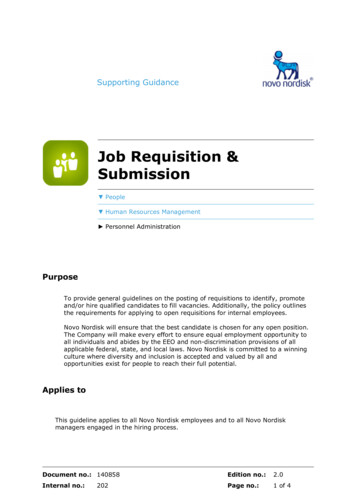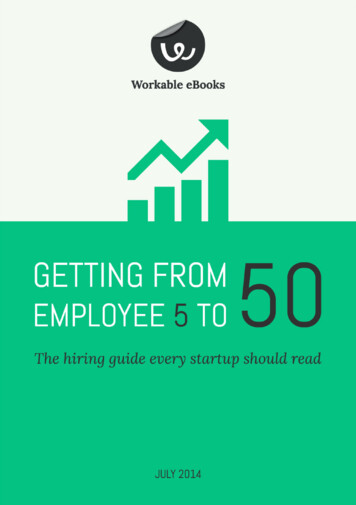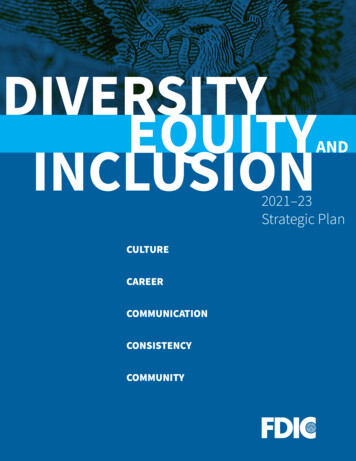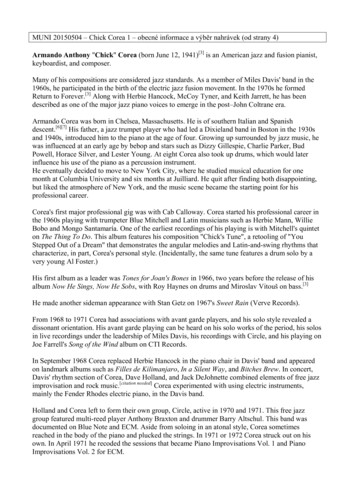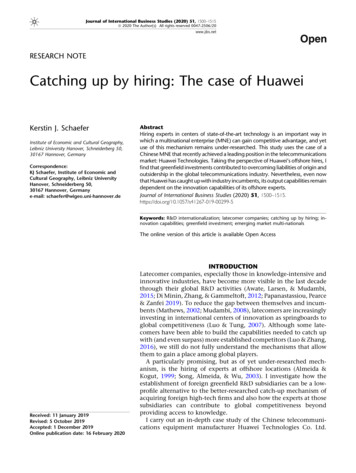
Transcription
Journal of International Business Studies (2020) 51, 1500–1515ª 2020 The Author(s) All rights reserved 0047-2506/20www.jibs.netRESEARCH NOTECatching up by hiring: The case of HuaweiKerstin J. SchaeferInstitute of Economic and Cultural Geography,Leibniz University Hanover, Schneiderberg 50,30167 Hannover, GermanyCorrespondence:KJ Schaefer, Institute of Economic andCultural Geography, Leibniz UniversityHanover, Schneiderberg 50,30167 Hannover, Germanye-mail: schaefer@wigeo.uni-hannover.deAbstractHiring experts in centers of state-of-the-art technology is an important way inwhich a multinational enterprise (MNE) can gain competitive advantage, and yetuse of this mechanism remains under-researched. This study uses the case of aChinese MNE that recently achieved a leading position in the telecommunicationsmarket: Huawei Technologies. Taking the perspective of Huawei’s offshore hires, Ifind that greenfield investments contributed to overcoming liabilities of origin andoutsidership in the global telecommunications industry. Nevertheless, even nowthat Huawei has caught up with industry incumbents, its output capabilities remaindependent on the innovation capabilities of its offshore experts.Journal of International Business Studies (2020) 51, 99-5Keywords: R&D internationalization; latecomer companies; catching up by hiring; innovation capabilities; greenfield investment; emerging market multi-nationalsThe online version of this article is available Open AccessReceived: 11 January 2019Revised: 5 October 2019Accepted: 1 December 2019Online publication date: 16 February 2020INTRODUCTIONLatecomer companies, especially those in knowledge-intensive andinnovative industries, have become more visible in the last decadethrough their global R&D activities (Awate, Larsen, & Mudambi,2015; Di Minin, Zhang, & Gammeltoft, 2012; Papanastassiou, Pearce& Zanfei 2019). To reduce the gap between themselves and incumbents (Mathews, 2002; Mudambi, 2008), latecomers are increasinglyinvesting in international centers of innovation as springboards toglobal competitiveness (Luo & Tung, 2007). Although some latecomers have been able to build the capabilities needed to catch upwith (and even surpass) more established competitors (Luo & Zhang,2016), we still do not fully understand the mechanisms that allowthem to gain a place among global players.A particularly promising, but as of yet under-researched mechanism, is the hiring of experts at offshore locations (Almeida &Kogut, 1999; Song, Almeida, & Wu, 2003). I investigate how theestablishment of foreign greenfield R&D subsidiaries can be a lowprofile alternative to the better-researched catch-up mechanism ofacquiring foreign high-tech firms and also how the experts at thosesubsidiaries can contribute to global competitiveness beyondproviding access to knowledge.I carry out an in-depth case study of the Chinese telecommunications equipment manufacturer Huawei Technologies Co. Ltd.
Catching up by hiring: The case of HuaweiKerstin Jutta Schaefer1501(Huawei), which is known for strategically hiringR&D experts outside its home country, earning it areputation for intense knowledge sourcing. Huaweistands out because of the rapidity with which itcaught up with the industry leaders in telecommunications, surpassing them in terms of annualrevenue and patent applications at the World Intellectual Property Organization (WIPO) (Lee, Joo, &Oh, 2016). In fact, Huawei was a technological leaderin China but had little left to learn in its homecountry so it turned abroad to access state-of-the-artknowledge (Boutellier, Gassmann, & Zedtwitz, 2008;Fan, 2011). In order to hire senior experts, it set upR&D units close to competitors, a strategy usedpreviously by Korean MNEs (Lee & Lim, 2001).Huawei’s reliance on offshore hiring to catch upmakes it an ideal subject for a case study exploringhow hiring offshore experts can provide competitiveadvantages. To identify the micro mechanisms of itscatch-up process, I explicitly take the perspective ofthe offshore experts in over 40 qualitative interviewsat eight different R&D locations. I identified potential interviewees using an original Huawei patentand scientific publication dataset, which I also usedto analyze the timeline of Huawei’s global R&Dactivities. I concentrated on the period leading up toHuawei’s global breakthrough to show how thecompany achieved competitive advantage from alatecomer position.I contribute to the literature on R&D internationalization and entry modes by investigatingmechanisms of a latecomer’s greenfield investments. Catching up by hiring goes beyond learning-by-hiring. To catch up, firms must overcomeliabilities of origin and of industry outsidership,and they can do that with offshore hires embeddedboth in the firm and in industry networks. I alsouncover the strong connection between Huawei’soutput capabilities and the innovation capability ofits offshore experts.THEORETICAL BACKGROUNDLiteratureI build on the Luo and Tung (2007, 2018) notion thatoutward foreign direct investment (FDI) serves as aspringboard for latecomer companies attempting tobuild competitive advantage and overcome latecomer disadvantages. Jumping off the springboardallows latecomers to leverage home-country competences and to make use of new opportunities abroadat the same time, which is in line with the dynamiccapability argument (Grøgaard, Colman, & Stensaker, 2019; Luo & Tung, 2007; Teece, Pisano, &Shuen, 1997). Competitive advantage can be built bycombining already-existing advantages, such asHuawei’s low labor costs and reputation for outstanding customer service, with new capabilities liketechnical and innovative skills.Latecomer companies are under pressure to compete globally while simultaneously defending theirhome market against established rivals (Hsu, Lien, &Chen, 2015; Luo & Tung, 2007). A common strategyfor latecomers is to try to move from lower to highervalue-added activities in global value chains byacquiring state-of-the-art technology from incumbents (Mathews, 2002; Mudambi, 2008), savingthemselves the time it took others to develop thosetechnologies (Chen, 2004). Asian companies areespecially known for strategically gaining expertisefrom abroad (Child & Rodriguez, 2005; Poon, Hsu, &Jeongwook, 2006). Earlier studies have looked atKorean and Taiwanese latecomers who caught up inthe 1970s, Samsung and LG Electronics for example(Cho, Kim, & Rhee, 1998; Lee & Lim, 2001; Miao,Song, Lee, & Jin, 2018). I analyze a company fromChina as a more recently emerging economy, andspecifically focus on its ‘‘emerging phase’’ in an effortto detect capabilities that latecomers need in order tocreate competitive advantage (Hernandez & Guillén,2018).Global incumbents benefit from internationalnetworks that have historically evolved (Meyer,Mudambi, & Narula, 2011). Latecomers, on theother hand, need to find ways to enter these despitetheir lack of connections and global industryembeddedness (Cantwell & Mudambi, 2011; Johanson & Vahlne, 2009). I propose that one strategythat can help overcome such restrictions is toleverage the inherent embeddedness of locationswhere employees, companies, and stakeholders arealready integrated in global industry networks.Here, the offshore expert dual embeddedness canprovide the firm that hires them with not only anentrée into the local context, but more importantlya way into the global industry network.Latecomers may also suffer from liabilities oforigin. Emerging market firms in particular oftenhave to contend with stereotypes that stem fromthe behavior of other home-country actors, including other firms and governments (Asmussen, 2009;Fiaschi, Guiliani, & Nieri, 2017). Being an industryoutsider from China added to Huawei’s struggle toenter the global telecommunications industry. Notonly industry incumbents attempted to block it,Journal of International Business Studies
Catching up by hiring: The case of HuaweiKerstin Jutta Schaefer1502but some Western governments such as the US didas well (Chung & Mascitelli 2015). Given theadditional obstacles it faced, the question is howHuawei managed to become a global technologyleader.According to the springboard perspective, theacquisition of foreign firms is the main means ofaccessing state-of-the-art knowledge (Luo & Tung,2007), but there have been recent calls in theliterature to shift the focus on other investmentmodes such as greenfield investments (Kumar,Singh, Purkayastha, Popil, & Gaur, 2019; Luo &Tung, 2018). Many scholars have assumed thatacquisitions are made to obtain strategic assets suchas technology and brands and that they can offerfast access to the business network of an acquiredfirm, while greenfield investments, which entailbuilding facilities from scratch, have thus far beenmainly ascribed to market-seeking motives (Anderson & Sutherland, 2015; Rui & Yip, 2008; Klossek,Linke, & Nippa, 2012). In this regard, Huawei is anatypical case, as it pursues knowledge-seekingstrategies through the establishment of greenfieldR&D subsidiaries, thus the analysis contributes toclosing a gap in our understanding of mechanismsof greenfield investments in knowledge-seekingR&D internationalization (Anderson & Sutherland,2015).Instead of acquiring firms for their knowledge,Huawei hires offshore experts, who are experiencedtechnical experts from technologically advancedcompetitors or research institutions at Huawei’soffshore locations, in order to tap their experienceand technical know-how. The extant literaturerecognizes the hiring of offshore experts as a wayto obtain state-of-the-art knowledge; ergo, learning-by-hiring (Almeida & Kogut, 1999; Song et al.,2003). Those experts have tacit and complexknowledge that is not easily codifiable, which canbe used to build up the company’s knowledge stock(Argote & Ingram, 2000). Incumbents on the otherhand are eager to preserve their competitivenessand attempt to reduce the inter-firm mobility ofhighly qualified employees through non-competecontracts and the threat of patent litigations(Campbell, Ganco, Franco, & Agarwal, 2012;Ganco, Ziedonis, & Agarwal, 2015). In order tobetter understand the value of offshore experts forHuawei, in this study I do not, as some have, focussolely on learning mechanisms, but adopt a broaderperspective, analyzing the eclectic role of experts increating competitive advantage. I achieved this byconducting interviews using an exploratoryJournal of International Business Studiesapproach leveraging the experts’ point of view inorder to allow for new insights into catching up byhiring. I was able thus to go beyond learning-byhiring and show how offshore experts improveHuawei’s embeddedness in global telecommunications industry networks.Context and DevelopmentWhen Huawei was founded in the late 1980s, globalplayers from Western countries such as Ericsson,Siemens, Nokia, Motorola, Alcatel, Nortel, andLucent dominated the telecommunications industry. In the early 2000s, the bursting of the IT bubblestarted a wave of consolidations that createdAlcatel-Lucent and Nokia-Siemens-Networks, andeventually led to Nortel’s bankruptcy in 2009 (Leeet al., 2016). This was an important factor in thedevelopment of Huawei, China’s own telecommunications market was another. When the DengXiaoping Open Door Policy began in 1984, Chinesetelecommunications technology lagged behindthat of the West by some 20 years. By the timeHuawei was founded, there was huge pent updemand, especially in rural areas (Mu & Lee,2005). It first sold cheaper low-end telecommunications infrastructure equipment in the countryside, which allowed it to avoid head-to-headcompetition with more technologically advancedforeign competitors, which were instead concentrating on large urban areas (Lee et al., 2016; Li &Cheong, 2016). Once its domestic market reached acertain degree of saturation, Huawei expanded salesto other emerging markets, India and Russia, and anumber of countries in Africa and Latin America(Lee et al., 2016; Micheli & Carrillo, 2016). Leveraging its low prices, familiarity with rapidly changing political conditions, and the political tiesbetween its home country and host countries,Huawei’s strategy was to become big by firstwinning emerging markets (Cooke, 2012; Li &Cheong, 2016; Micheli & Carrillo, 2016). AgainHuawei avoided direct competition with globalplayers while it built expertise and grew.The next step was to tackle the low quality of itsproducts. In the mid-2000s, it started to expand itsR&D activities to global innovation centers outsideChina. Today, Huawei does its most impactful R&Doffshore, as shown by the fact that its higherquality patents are created by its offshore incontrast to domestic employees (Schaefer & Liefner,2017). Geographic, cultural, and institutional distance had little impact on the sequence of Huawei’sR&D investments, as the company entered Western
Catching up by hiring: The case of HuaweiKerstin Jutta Schaefer1503technology centers such as Silicon Valley early onin 1993 (Fan, 2011). Huawei’s disregard for culturaland institutional distance was a result of thecompany following the location choice of globalindustry leaders, but this proved a major hurdle forthe company for gaining legitimacy. Still now,Huawei’s strategy prioritizes internal innovationsover acquired ones, thus it locates close to competitors in order to hire technological experts(Chang et al., 2017). Cooke (2012) observes thatHuawei’s offshore subsidiaries usually start out witha small team of Chinese expatriates who then hirelocal employees. Huawei also upgraded its technological capability through strategic foreign R&Dcooperation—for example, it formed alliances withTexas Instruments, Sun, and Intel (Lee et al., 2016),and in the early phase of internationalizationpursued fast and unidirectional knowledge absorption from university collaborations (Liefner, Si, &Schaefer, 2019).As a privately owned firm, Huawei did not receivefinancial incentives from the China DevelopmentBank as did its state-owned competitors. This didnot change until the mid-2000s when the Chinesegovernment helped it in its efforts to internationalize as part of the Going Global Policy. Thatsupport enabled the company to expand its sales toestablished markets, which it again did by initiallyselling products at very low prices in order to builda customer base (Cooke, 2012; Micheli & Carrillo,2016; Nolan, 2014). Unlike its experience in emerging markets, in the West Huawei came up against ahostile political climate, the US even accusingHuawei of espionage, an accusation some see asdirected at the Chinese government (Cooke, 2012;Chung & Mascitelli, 2015). Just as it had stymiedstate-owned Chinese companies previously, the USgovernment stood in the way of Huawei makingacquisitions and barred it from bidding for nationalnetwork projects, causing Huawei to focus onEuropean, Canadian, and Australian markets (Anderson & Sutherland, 2015; Chung & Mascitelli,2015; Nolan, 2014). Despite these roadblocks, by2008 Huawei became the number one patentapplicant at WIPO and in 2012 surpassed industryleader Ericsson in annual revenue (Lee et al., 2016).Huawei was a late entrant in the standardizationprocess for the fourth generation of wireless systems (4G), but it became a main contributor to thefifth (5G).When making generalizations from case studies,one needs to take into account its specificities(Brinkmann & Kvale, 2018; Yin, 2014). In Huawei’scase, this includes government-provided advantages (Gaur, Ma, & Ding, 2018) such as access tocheap capital, which allows the company to takegreater risks, a bad reputation in the West, even incomparison to other Chinese companies, andgeopolitical risk, as the latest developments in thetrade dispute between the US and Chinademonstrate.METHODSResearch DesignTo answer ‘‘how’’ using the among Chinese MNEsuncommon strategy of hiring offshore expertsinstead of acquisitions helps Huawei to createcompetitive advantage on a global scale, a casestudy design was deemed most appropriate becauseof the high complexity of the phenomenon (Birkinshaw, Brannen, & Tung, 2011; Ghauri, 2004;Marschan-Piekkari & Welch, 2004; Yin, 2014). Thisresearch design makes it possible to unbundleinterrelated and consecutive processes; forinstance, experts at offshore locations using theircontacts to approach further potential employees,which starts a self-reinforcing spiral that helps thebusiness unit and its network to grow. Previousresearch has identified a lack of qualitative studieswhen it comes to knowledge-seeking subsidiaries,leading to a lack of in-depth understanding of thephenomenon (Michailova & Mustaffa, 2012). Doz(2011:587) argues that a qualitative study can makea crucial contribution as it ‘‘allows a conceptualization from the standpoint of the actors at work’’. Theresearch design I adopted for this case study allowsme to tap into the perspective of offshore experts inorder to uncover their role in the company’s catchup. In order to capture variations between locations, I interviewed experts at Huawei’s majorpatent- or scientific publication-producing offshoreR&D labs (Birkinshaw et al., 2011), hence the R&Dsubsidiaries form the meso-level of analysis. Theaggregated level of analysis is the company itself,and the goal is the big picture, Huawei’s R&Dinternationalization. The case is embedded in thecontext of the global telecommunications industry,as the interviewees all have profound knowledge ofthe industry and are able to situate their experiencewithin the context of the industry, providing bothan insider’s and an outsider’s perspective on thecompany. This means that the study has features ofan embedded case study method as well as amultiple case study design (Yin, 2014).Journal of International Business Studies
Catching up by hiring: The case of HuaweiKerstin Jutta Schaefer1504Some interviewees were current Huawei employees, others former ones. Another feature of thestudy design intended to ensure critical distancefrom the company is that I did not ask managersabout their aims, but instead asked engineers abouttheir practical tasks. This provided a check on thekind of one-sided company-created narrativesTokatli (2015) warns are the ‘dark side’ of firmcentric case studies. In line with this, I adopted anexploratory approach with mainly inductive category building to stay open to new interpretations ofthe offshore expert role in generating competitiveadvantages (Doz, 2011; Flick, 2018).Data and AnalysisThe main findings of my qualitative analysis aredrawn from semi-structured interviews. I identifiedpotential interviewees and obtain a broader pictureof the company’s R&D activity using three databases, PatentsView for data from the United StatesPatent and Trademark Office (USPTO), PATSTAT forthe European Patent Office (EPO), and Elsevier’sScopus for publication data. The experts I selectedto ask for an interview were either at the time orpreviously employed at an offshore location ofHuawei Technologies or at Huawei Device, Futurewei or HiSilicon, Huawei subsidiaries. As the inventors listed on patent applications filed by Huaweiare not necessarily employed by Huawei (Ge,Huang, & Png, 2016), I used online social mediaplatforms such as LinkedIn and ResearchGate toinvestigate which experts were, or had been,employed by the company. There is a clear breakpoint in the number of patents and scientificpublications per location, eight of them being farand away the most active: Munich, Stockholm,Dallas, San Jose, San Diego, Bridgewater, Chicago,and Ottawa. Together they account for more than90% of Huawei’s offshore patents filed with theUSPTO and 88% with the EPO, as well as 73% of alloffshore scientific publication activity. I contacted233 inventors using LinkedIn and e-mail and wasable to do 42 interviews. I carried out interviewsbetween February and September 2017, some inperson, others via Skype or telephone; in one case Iconducted a follow-up interview. I decided againstinclusion in the analysis of one interview simply forlack of usable information. Twenty-four of theremaining 40 interviewees were located in the USand Canada, 14 others in Europe. Two intervieweesdid not have a fixed location.The majority of interviewees were offshoreexperts, that is, they were experienced technicalJournal of International Business Studiesexperts whom Huawei hired from technologicallyadvanced competitors or research institutions outside of China and two interviewees were Chineseexpats, educated in China and previously employedby Huawei China. In addition to their professionalexperience, all of the offshore experts had a tertiaryeducation at one of the universities located inWestern hotspots of the global telecommunications industry. Four of the interviewees had aChinese university undergraduate education beforegetting a higher degree or taking an academicposition abroad. These interviewees were able toprovide a cultural insider’s perspective. Many ofthose interviewed in the US and in Canada werefrom India or a country in South America, theMiddle East, North Africa, or East Europe, but all ofthem had had some education in North America orhad worked there before Huawei hired them. Thoseinterviewed in Europe were mostly from withinEurope. The interviewees without exception weremales. This is reflective of the industry as I was ableto identify less than 0.1% females among theoffshore inventors and none agreed to an interview.Finally, across the board, former employees weremore open to sharing insights than current ones,the latter were also reluctant to share negativeexperiences.The main questions posed in the semi-structuredinterviews are provided in the ‘‘Appendix’’. Thereare three blocks of questions, the first about previous employment, coming to work at Huawei, andthe particular lab joined, the second about externalcontacts and influence, and the third about theirtasks and role within Huawei. The professionalbackground responses provide information aboutthe kind of knowledge and contacts Huawei is ableto access abroad. Responses to the second set ofquestions provide information about the extent ofexternal contacts and how they might be used, aswell as the possibility of external barriers toHuawei’s operations. Finally, responses to questions about tasks and work partners within thecompany throw light on the internal role ofexperts. I employed qualitative analysis softwareusing MaxQDA. Coding the text helped me toidentify general patterns as well as complex interrelationships. The main codes follow the guidelinesof the semi-structured interviews and therefore arebased on theoretical considerations. All of thesublevel categories evolve from open coding, usingan exploratory research approach to generate findings from the micro-level (Gibbs, 2018). I comparedthe interviewees’ responses using cross tables that
Catching up by hiring: The case of HuaweiKerstin Jutta Schaefer1505Table 1 Interviewee variablesName of thematic setVariablesLocation: city levelDallas/San ckholmUndefinedUSA/CanadaEuropeCurrentFormer\ 4 years4–7 years[ 7 yearsAcademiaCompetitorHuawei ChinaChineseNon-ChineseR&DManagementSalesEarly activities(\ 2009)Rapid expansion(2009–2013)Take-over ([ 2013)Location: regional levelEmployment statusEmployment lengthFormer employerCultural backgroundPositionHuawei’s R&Dinternationalizationphase duringemployment (notdisjoint)Number split the material along variables used to processbackground information on the interviewees.Table 1 shows the interviewee variables by themeand the number of interviewees per category. Thisis not intended to quantify the qualitative data orimply that the interviews can be weighed inanyway against one another, but to give a moretransparent overview of the material.To preserve confidentiality, I coded the materialalone in two iterations at different points in time inorder to bolster coding reliability and to ensureanalysis quality. I shared my findings with one ofthe interviewees who I found had provided exceptionally broad insights and used his feedback tocritically review the results (Brinkmann & Kvale,2018).A limitation of the data is that it only shows theparts of Huawei’s R&D that resulted in patents andscientific publications. Nevertheless, Huawei isknown to encourage patenting and strongly incentivizes employees to do so. This is why the data is agood proxy for the company’s R&D activity inWestern markets. Another limitation is that theperspective of offshore experts does not reflect theintentions of the company’s management. Thismeans that it is difficult to know if managementdecisions were made deliberately or in response tocircumstances.Further, a review of print media on the topics ofHuawei appointing foreign retired officials andpoliticians to local boards and hiring lobbyistsshows its efforts to obtain political expertise. Isearched Google News under ‘‘Huawei’’ with keywords ‘‘lobby*’’, ‘‘board’’, ‘‘board member*’’, ‘‘hire/hiring’’, and ‘‘official*’’. Table 2 in the ‘‘Appendix’’gives an overview of 17 articles appearing between2010 and 2015 in Australia, the UK and the US.RESULTS AND DISCUSSIONHuawei’s Offshore R&D in the Global ContextThe publicly available data on Huawei’s offshoreR&D is neither detailed nor consistent, therefore Iuse patent and scientific publication data to trackthe company’s activity. Figure 1 provides an overview of activity at Huawei’s main offshore locations. Differences in patent regulations between theUSPTO and the EPO make it impossible to directlycompare the number of patents filed betweenthem, although I am able to illustrate in thefigure Huawei’s intense R&D output, especially inthe US, which is remarkable given that the company has very few sales in that market.The interviews make clear that Huawei’s R&Dlocation choices abroad often followed the locationof competitors. The downsizing of a rival couldmean an opportunity for Huawei to hire expertswithout running into non-compete agreementproblems. The company targeted Ericsson expertsand set up its own facilities in Stockholm and SanDiego when the Swedish firm downsized in thosecities. Huawei also appears to have been motivatedby the bankruptcy of Nortel to open a facility inOttawa where it was able to hire entire teams thatlost their jobs.Moreover, following the location of competitorsprovides access to established infrastructure for aparticular technology at a given location, such asuniversity departments focusing on technology inwhich Huawei was interested in the case of Ottawaand Munich. In San Diego and Dallas Huawei wasable to tap into supplier and customer networks.Hiring from competitors is not uncommon in theindustry, but interviewees emphasized the extentto which Huawei used them was unusual. In somecases, Huawei located offices only meters fromJournal of International Business Studies
Catching up by hiring: The case of HuaweiKerstin Jutta Schaefer1506Figure 1 R&D output of Huawei’s offshore locations.competitors. That was seen by some in the industryas being aggressive, but many employees welcomedthe job option at Huawei after losing their previousjob. Depending on the shortage of local alternatives, such as in Ottawa compared to the manyopportunities in San Jose, many of them did nothave to relocate because of the job at Huawei. Thisis not to say that all experts were ‘‘pushed’’ to workfor Huawei. Huawei was offering higher salaries anda range of perks including more professionalfreedom.Each of Huawei’s offshore labs specializes in adifferent portfolio of technologies. As it follows thecompetition, those portfolios are driven by thefocus of competitors and by extension by the keypersonnel Huawei might be able to hire. In otherwords, Huawei’s offshore experts influence thecompany’s local specialization. For example, inDallas, the primary focus is on telecommunications, whereas in Silicon Valley it is on Internetproducts. Likewise, in some locations there is morecooperation with universities than in others thattend, for instance, to concentrate on work instandardization.Figure 2 distinguishes between three differentphases in Huawei offshore R&D output, startingJournal of International Business Studieswith the first from the Stockholm lab in 2004followed by smaller labs in Dallas, San Jose, and SanDiego in 2006. Interviewees from Stockholmexplained that Huawei started there under thename Atelier Telecom to avoid attracting attention;it was renamed Huawei in 2004. The oldest locations in the US are Dallas, San Diego, and someminor activities in Silicon Valley. Between 2009and 2013, Huawei started to expand its offshoreR&D more rapidly and, early in this phase, majorlocations in Munich, Chicago, Bridgewater, andOttawa started generating output. In addition,Huawei’s labs in Silicon Valley became more activearound 2011. After Huawei overtook its competitors in terms of revenue in 2014 (the take-overphase in Figure 2), there was another surge inoutput, but fewer new locations. This coincideswith heavy recruiting by Huawei to take advantageof some industry incumbents cutting back as thefourth generation of wireless systems (4G) was atthe end of its technological life cycle and the fifth(5G) not yet ready for the market.Very early in its R&D internationalization process, Huawei emphasized patenting to increase itsportfolio and improve its position in negotiationsfor license fees. The company filed a tremendous
Catching up by hiring: The case of HuaweiKerstin Jutta Schaefer1507Figure 2 Development of Huawei’s offshore R&D.number of them, primarily to signal technologicalcompetence. Recently, Huawei has changed course,not concentrating on their quantity, but filingpatents for high-quality ones.The Role of Offshore ExpertsThe role of the offshore experts during Huawei’sentrée in the global industry fall into five categorie
I carry out an in-depth case study of the Chinese telecommuni-cations equipment manufacturer Huawei Technologies Co. Ltd. Received: 11 January 2019 Revised: 5 October 2019 Accepted: 1 December 2019 Online publication date: 16 February 2020 Journal of Int


